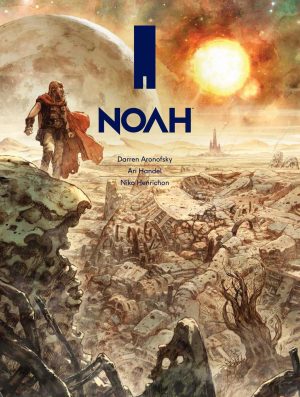Review by Ian Keogh
Best remembered for the introduction of legacy character Dan Dare in the 1950s, The Eagle’s original publisher was Marcus Morris, a vicar by trade. His concept of the comic was something wholesome and spiritually uplifting from which readers would learn, so the SF adventures were the hook, but always accompanied by educational features such as biographies of the renowned.
Feeding into the theme of moral guidance, The Eagle also serialised adaptations of stories from the Bible, two of which are collected here in an oversized format heading most of the way to the size at which they were originally presented.
In 1960-1961 the 56 pages of ‘The Road of Courage’ proved Frank Hampson’s final work for the title he co-founded, with the script provided by Morris. Hampson and Morris had first collaborated on a parish magazine, and adapting the life story of Jesus was a project dear to Morris’ heart. Unlike Dan Dare, where he depended heavily on assistants for his regular workload, the skilled drawing here is provided by Hampson alone. Colour is sympathetically applied by Joan Porter, but the detailed locations, expansive scenery and rich personalities are all Hampson. His art is subtle, downplaying rather than sensationalising miracles, and his Jesus contemplative.
Morris chooses not to present a straight Biblical adaptation, pulling from all four gospels and adding his own narrative structures, such as starting with the petty criminal Bar-Abbas, and returning to him as a later revolutionary leader. He frequently slips in educational references, such as having school pupils learning the Jewish alphabet, but transforms the story to stirring adventure featuring the hypocritical Pharisees and frequent action scenes involving Roman troops. Unusually considering his background, Morris also couches much of the early chapters in terms of uprisings, yet transmits the necessary Biblical messages. Not credited is Guy Daniels, who supplied the script once Hampson completed each page.
Gospel writer Mark features in the second story, serialised in 1954, and written by another priest, Chad Varah, whose legacy was even greater through founding the Samaritans. This is more obviously children’s adventure, Varah focussing on the young Mark learning ahead of time that Judas plans to betray Jesus leading to his arrest. Contrast is provided by also spotlighting the household of Roman governor Pontius Pilate, portraying him as a self-interested political pragmatist. Varah delivers a suspenseful adventure, but peppers his dialogue with English colloquialisms intending to indicate a timeless story in the 1950s. It makes for jarring reading now.
Italian artist Giorgio Bellavitis also has a legacy, eventually returning to his homeland to be instrumental in the conservation and restoration of Venice. His illustrative style suits the times portrayed, and he loves a tortured expression, taking his lead from classical painting, which also surely influences his layouts. People are more likely to be seen as full or three-quarter figures and care is taken to show how clothing, primarily robes, moves with them. Interestingly, although Jesus features frequently, Bellavitis never shows him face-on.
Because both features are in effect period dramas they haven’t dated as much as the more highly regarded Dan Dare, and whether or not you have Christian leanings, the art is seductive.





